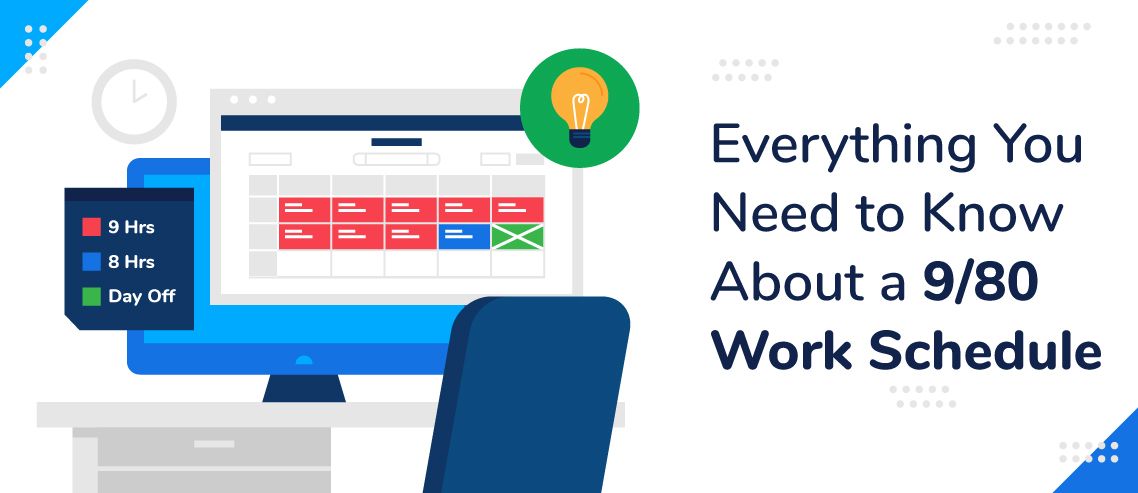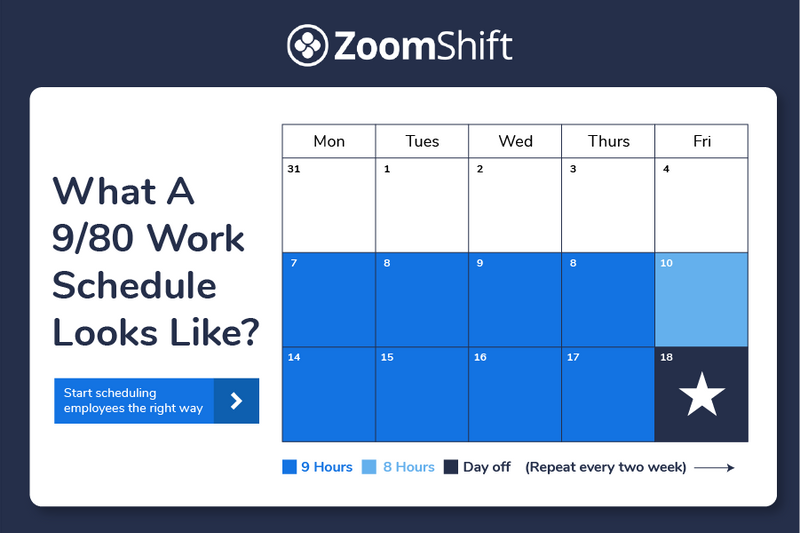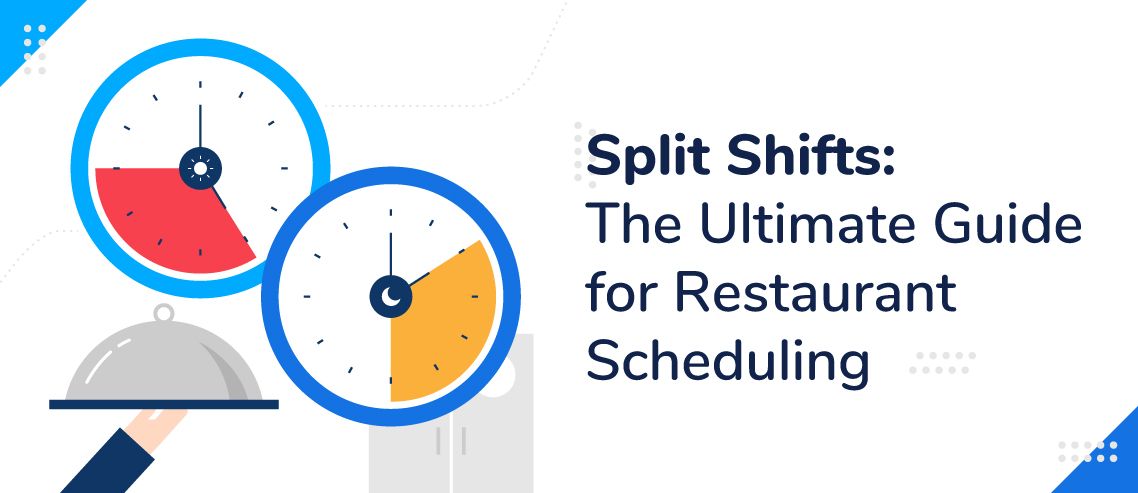9/80 Work Schedule — Everything You Need to Know

The best work schedules find a balance between getting things done and giving employees the most time off. This in turn maximizes customer satisfaction and work-life balance, which creates greater engagement, productivity, and loyalty, to name a few benefits.
The call for work-life balance is greater than ever. Employees want the flexibility to run errands, get things done around the house, and spend more time with their loved ones.
Naturally, flex scheduling is incredibly popular these days. Employers see the benefits, and employees are seeking out companies who offer them. Some companies are even trying out four-day workweeks. For instance, Microsoft Japan implemented four-day workweeks and claimed that their productivity shot up 40%.
So why isn’t everyone jumping on board?
For small businesses, implementing flex scheduling is challenging. While employees want flexibility, consumers want 24/7 availability, next-day shipping, and impeccable service around the clock. As a result, many companies are testing the waters of flexible scheduling with the 9/80 work schedule.
What is a 9/80 Work Schedule?
A 9/80 work schedule looks at a two-week period and splits the working days into eight 9-hour days and one 8-hour day.
For a standard workweek, that would mean working nine hours a day Monday through Thursday the first week, with Friday being an eight-hour day. In the second week, you’d work nine hours a day Monday through Thursday, which leaves the second Friday completely off since you hit eighty hours on Thursday.
It doesn’t necessarily have to be that exact breakdown, but that’s the most common 9/80 work schedule.

9/80 schedule example
Week 1
- Monday: 9 hours
- Tuesday: 9 hours
- Wednesday: 9 hours
- Thursday: 9 hours
- Friday: 8 hours
Week 2:
- Monday: 9 hours
- Tuesday: 9 hours
- Wednesday: 9 hours
- Thursday: 9 hours
- Friday: DAY OFF
What Are the Benefits of a 9/80 Work Schedule?
A) For employees
1. Better Work-Life Balance
26 three-day weekends per year promote work-life balance by giving every staff member an extra day off every other week.
That extra day off means more family time — employees can take advantage of a three-day weekend to take an extended trip, and parents can spend more time with their children and attend their children’s school or extra-curricular events they may have otherwise missed.
2. More Flexibility
Having a weekday off provides the flexibility to get some errands or chores done that are easier to do during the week. This might be attending appointments with primary care physicians or government agencies that may only be open during the week.
For parents, this might also enable them to attend school-based activities that lie during the weekdays. Implementing a 9/80 work schedule empower business to be more flexible.
3. Less Commute
The one extra day off every other week means that, over the course of a year, the commute to the office is significantly reduced, which saves time, fuel, and ultimately money.
B) For employers
1. Fixed schedule
The 9/80 schedule, whilst being more flexible for employees, remains a fixed schedule for the employer, providing exactly the right amount of coverage they need. This helps employers plan ahead and forecast coverage and budget costs effectively.
2. Boost employee performance and productivity
The better work-life balance and the increased flexibility give employees a greater sense of control over their schedules, leading to better morale in the office. The outcome of this: more gets done each day. In short, allowing employees more flexibility directly impacts their productivity.
3. Attract new hires
The 9/80 work schedule can be an attractive proposition for new recruits because it demonstrates a more flexible approach to employment than some other employers. The pull of the work-life balance, and the extra day off a fortnight, are bonuses that might just sway prospective applicants to want to work for you.
Plus, it might just be one of the benefits that keep your employees loyal.
As you can see, a 9/80 schedule is a win-win for everyone involved.
That said, there can also be some drawbacks to this type of arrangement.
What Are the Cons of a 9/80 Work Schedule?
1. Not suitable for all business
From an organizational standpoint, a 9/80 schedule makes for a more challenging payroll structure that isn’t necessarily right for every business.
If you’re basing payroll on single workweeks, then things are off-balance since week 1— will show 44 hours worked, while week 2 — shows 36. This structure only really makes sense If you’re operating on a bi-weekly pay period.
2. Longer workdays
The 9/80 schedule makes for slightly longer working days. Working later most days will mean you get home later and have less time to enjoy your weeknights. It also means that your energy levels are likely to dip as your day gets longer, which could potentially affect your productivity or ability to enjoy your interests after work.
3. Fixed schedule
Whilst having a fixed schedule might be beneficial to some employers and employees, it’s not always right for everyone. Depending on the nature of the role, or the business, some extra flexibility within the schedule may be more appropriate.
4. Managing time-off requests
The 9/80 work schedule works well in theory but can have issues when time off is requested.
For example, when an employee requests time off when most other employees are on their three-day weekend, then coverage may be compromised.
How Do You Run Payroll for a 9/80 Work Schedule?
A typical pay cycle runs Monday through Sunday or Sunday to Saturday. Since a 9/80 work schedule leaps across work weeks with 44 hours worked in the first week and 36 hours in the second half, you have to be careful about how you add things up.
If done incorrectly, you could end up paying 4 hours of overtime the first week. As previously stated, it’s recommended that you run payroll based on a two-week schedule.
This doesn’t completely put you in the clear, though. PTO days also work differently, since they’ll often count as nine hours off unless it’s a Friday. The same goes for holidays.
Also, some states like California count overtime as any hours more than eight in a day, so it may not be ideal for businesses there. It’s best to consult experts like your attorney, accountant, and HR business partners before implementing such a change to make sure you cover all your bases.
Common Pitfalls in Using 9/80 Schedules
Despite the potential benefits of a 9/80 work schedule, there are some common mistakes that employers make when implementing it.
These mistakes can lead to problems in managing payroll, tracking time-off requests, and ensuring proper coverage during working hours. They can also trigger overtime liability.
Pitfall #1: Failing to consult with experts before making changes to payroll and scheduling
Implementing a 9/80 schedule can have significant effects on payroll and scheduling. It’s important to consult with experts such as your attorney, accountant, and HR business partners before making any changes to ensure compliance with labor laws and regulations.
Pitfall #2: Not considering the specific needs of employees or departments
Not all employees may be able to work under a 9/80 schedule due to personal or job-related reasons. It’s important to take into account the specific needs of each employee and department before implementing this schedule.
For example, employees with young children may prefer more flexibility in their schedules, while certain departments may require coverage during traditional off days.
Pitfall #3: Failing to communicate and involve employees in the decision-making process
Changing a work schedule can have a significant impact on employees’ personal lives and productivity. It’s important to communicate with employees and involve them in the decision-making process to address any concerns and ensure a smooth transition.
Pitfall #4: Allowing employees to switch their regular day off
While flexibility may be a perk of a 9/80 schedule, changing regular days off can trigger overtime liability. For instance, if an employee was supposed to have Friday off in week 2 but ends up working on that day, it may result in overtime pay for the extra hours worked.
Pitfall #5: Not scheduling workweeks properly
Proper scheduling is key to avoiding costly overtime payments. In a 9/80 schedule, an employee ends up working 36 hours in their first week and 44 hours in the second week. This means they are entitled to four hours of overtime pay in the second week.
One way to address this is by officially commencing the employee’s workday in the second week four hours after they start working. For instance, if their shift begins at 8 am, consider starting the workday at noon. This adjustment ensures that the employee completes a total of 40 hours in the second week, eliminating eligibility for overtime pay.
How to implement a 9/80 work schedule in your organization
1. Discuss with the employees
Implementing a new scheduling structure can affect all aspects of an employee’s life. Depending on their out-of-work responsibilities (e.g. families, school or nursery-aged children, hobbies) and their role within the company, they may have very strong feelings about whether they’re on board with a 9/80 schedule.
As an employer, you owe it to your staff to discuss the schedule change, point out the relevant benefits, and give them a chance to air their grievances or ask questions.
2. Confirm team availability
Once you’ve determined that 9/80 is right for your company, it’s important you start out by finding out your employees’ availability so that you can fit the schedule around them as much as possible.
3. Create a test schedule with a template
It’s always a good idea to run a test before firmly implementing a 9/80 schedule. With ZoomShift you can create a test schedule with a pre-designed template which you can.
4. Simplify shift swapping
It’s a fact of life that no matter how good your scheduling, your employees are bound to want to swap shifts from time to time. Better this than last-minute no-shows. Make it easy to swap shifts using a tool like ZoomShift that simplifies the process, keeping everyone in the loop and ensuring all shifts are covered.
5. Create a feedback loop
Even if your team is fully confident in entering into a new schedule of 9/80, it may take some time for everyone to adjust. Create the space and opportunity for your employees to feedback on any teething problems so that you can fix them promptly.
Maintaining open communication is the only way to troubleshoot problems and ensure you know when your new scheduling system is working for everyone involved.
Is a 9/80 Work Schedule Right for Your Business?
This largely depends on your industry and the size of your workforce. If you’re staffing software engineers who aren’t directly facing customers, then a 9/80 work schedule could work perfectly.
However, if you’re an artisanal bakery that’s open seven days a week and can’t accommodate an entire day off, then it might not be for you. That said, if your staff is large enough, they could rotate which days they’re off so that the bakery can always remain open.
There’s definitely some flexibility with the 9/80 work schedule, and if you deploy the right employee scheduling software like ZoomShift, then the entire process becomes even easier.
ZoomShift makes it easy to copy work schedules from week to week, so your 9/80 schedule is essentially on autopilot. Your team also benefits from having a central source of truth where they can find the most up-to-date work schedule alongside any relevant communication like work shift cover requests, shift schedule changes, or general announcements.
We can help you set up a 9/80 work schedule and streamline your scheduling process in ZoomShift. Start your 14-day free trial today!
JD enjoys teaching people how to use ZoomShift to save time spent on scheduling. He’s curious, likes learning new things everyday and playing the guitar (although it’s a work in progress).



